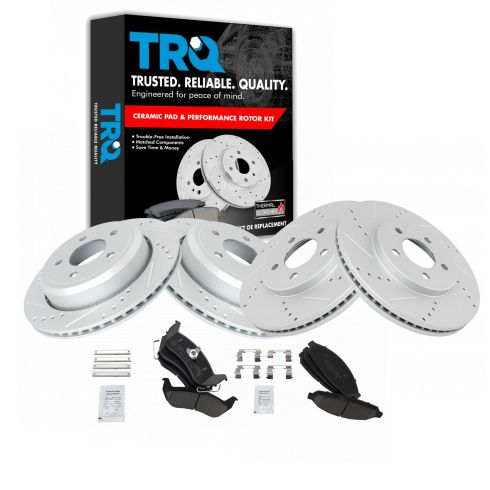1APBS00540-Ford Mercury Front & Rear Ceramic Performance Brake Pad & Rotor Kit TRQ Performance BKA12434

Replaces
2008 Ford Crown Victoria Front & Rear Ceramic Performance Brake Pad & Rotor Kit TRQ Performance BKA12434

Product Reviews
Loading reviews
4.88/ 5.0
16
16 reviews
Good parts good price
September 10, 2018
All of my parts fit without any problems! Great quality, fast shipping and a good price!
Thanks,
Great Brakes
December 6, 2018
Great stopping power. No noise overall great performance brakes.
Great product
November 13, 2019
By far the best set of rotors and brake pads Ive ever purchased, the customer service rep was very knowledgeable and friendly, but to top it off I received everything in 3 days
Front & Rear premium posi ceramic cross drilled & slotted performance brake kit
November 15, 2019
I have not installed this kit just yet, but I am very happy with my purchase and if I had another vehicle that uses the same kit I would not hesitate to purchase this kit again.
Great quality for a great price
December 4, 2019
I would highly recommend these, the installation is very straightforward and easy, provides great braking once heated up.
VERY NICE FULL BRAKE SET FOR P-71 CROWN VIC
February 18, 2020
I WAS VERY IMPRESSED WITH THE ROTORS AND PADS, EVERYTHING INCLUDED WITH THE SET MAKING THE SWAP VERY SIMPLE. GOING TO ORDER ANOTHER SET FOR MY WIFE'S 03 CROWN VIC. BRAKES ARE NOW THE QUIETEST I HAVE ON ANY CAR. PUT A NEW SET OF RUBBER ON THE 09 CV AND EVEN THE OWNER OF THE SHOP WAS IMPRESSED WITH THE QUALITY OF THE ROTORS AND PADS. IF ONLY FED EX COULD GET THEM TO ME WITHOUT THEM LOOKING LIKE THEY HAD BEEN IN A WAR ZONE, AND THE ORIGINAL PACKAGING WAS STOUT TO SAY THE LEAST, BUT NOTHING WAS DAMAGED!
First Time Buyer
January 22, 2021
I had gone to many websites and many local auto stores to get rotors and brake pads for my crown victoria and everything was way over priced. I was a little worried about the price reflecting the quality of the product but does not even come to mind now! I do alot of driving through the mountains so I do alot of braking from all curves and these brakes and rotors are superb. I highly recommend them, save your money and do not over spend when you can get same quality parts for half the price.
November 9, 2021
So far after 3000 miles they have been flawless.
August 6, 2022
The work great
Great product
August 16, 2022
Just what I ordered.
Was easy to install.
Truly improved my braking performance
November 18, 2022
Awesome quality, I highly recommend these brakes and rotors
December 19, 2022
Always the best!
Stopping Power
July 23, 2023
Better brakes with stopping power
More stopping power
August 23, 2023
I. Can definitely tell the difference with my newly installed brakes & rotors thanks so much 1-A auto
1A is an A++ rated auto parts provider
April 19, 2024
1A Auto is my go to source for high quality and high performance auto parts. Always has outstanding pricing and offers instructional videos for easy installation. Definitely worth your time and money to shop at this website over normal auto parts shops that offer same parts but higher prices. You won't be disappointed with what 1A Auto has to offer
RETURN
April 21, 2024
cost to return item high, meaning A1 does not give you all your money back.
Customer Q&A
Are these pre-bed or do I need to bed them in?
September 21, 2022
10
These brakes are not pre-bedded.
September 21, 2022
Jessica D
10
It is what I bought and put on my car they're ready to go on and they work great
October 3, 2022
Bill B
Ford is a registered trademark of Ford Motor Company. 1A Auto is not affiliated with or sponsored by Ford or Ford Motor Company.
See all trademarks.



















